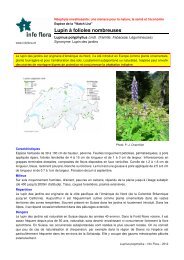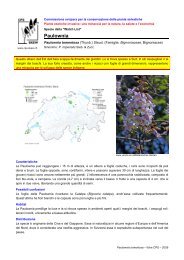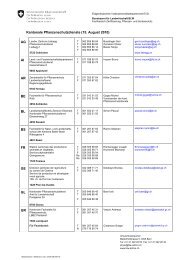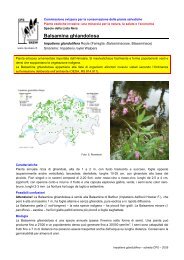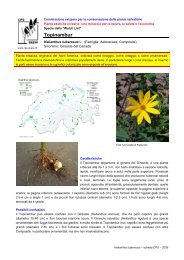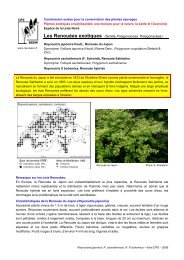Invasive Neophyten in der Schweiz: Lagebericht und ...
Invasive Neophyten in der Schweiz: Lagebericht und ...
Invasive Neophyten in der Schweiz: Lagebericht und ...
Erfolgreiche ePaper selbst erstellen
Machen Sie aus Ihren PDF Publikationen ein blätterbares Flipbook mit unserer einzigartigen Google optimierten e-Paper Software.
8<br />
<strong>Invasive</strong> alien plant species (<strong>in</strong>vasive neophytes) <strong>in</strong> Switzerland:<br />
report and need for action<br />
Summary of “<strong>Invasive</strong> <strong>Neophyten</strong> <strong>in</strong> <strong>der</strong> <strong>Schweiz</strong>: <strong>Lagebericht</strong> <strong>und</strong> Handlungsbedarf”, Gigon A. &<br />
Weber E., 2005. Report SKEW/CPS for the BUWAL, 40 pp.<br />
An overview is given regard<strong>in</strong>g naturalised alien species of the Swiss flora especially the <strong>in</strong>vasive<br />
alien species.<br />
1. Accord<strong>in</strong>g to the Red Lists (Moser et al. 2002, but without species of category C), the Swiss flora<br />
presently encompasses a total of 2943 species of which 350 (12%) are alien species, i.e. species<br />
naturalised <strong>in</strong> Switzerland after the year 1500 due to human activity and reproduc<strong>in</strong>g themselves<br />
(these species are called neophytes <strong>in</strong> German and other languages). About 10% of these i.e. the<br />
<strong>in</strong>vasive alien species (IAS), can cause problems. This has not been the case (up to now) for the<br />
other 90%.<br />
2. In this report, alien plant species are un<strong>der</strong>stood as <strong>in</strong>vasive (<strong>in</strong> German: <strong>in</strong>vasive <strong>Neophyten</strong>) if<br />
they disperse easily, propagate efficiently and cause damage <strong>in</strong> the areas of biodiversity, health,<br />
and/or economy or have the potential to do so. They are classified <strong>in</strong> the Black List or the Watch<br />
List. Both lists have to be revised every 5-10 years.<br />
3. The Black List (BkL): Register of alien <strong>in</strong>vasive plant species of Switzerland that actually cause<br />
damage. In general, these species have to be controlled. The follow<strong>in</strong>g 20 species are currently on<br />
the Black List of Switzerland: Ailanthus altissima, Ambrosia artemisiifolia, Artemisia<br />
verlotiorum, Buddleja davidii, Elodea nuttallii, Heracleum mantegazzianum, Impatiens<br />
glandulifera, Lonicera japonica, Ludwigia grandiflora, Lysichiton americanus, Polygonum<br />
polystachyum, Prunus serot<strong>in</strong>a, Reynoutria japonica (= Polygonm cuspidatum = Fallopia<br />
japonica), R. sachal<strong>in</strong>ensis, Rhus typh<strong>in</strong>a, Rob<strong>in</strong>ia pseudoacacia, Rubus armeniacus, Senecio<br />
<strong>in</strong>aequidens, Solidago canadensis s.l. (<strong>in</strong>cl. S. altissima), S. gigantea (= S. serot<strong>in</strong>a).<br />
4. The Watch List (WL): Register of alien <strong>in</strong>vasive plant species of Switzerland, which have the<br />
potential to cause damage or already cause damage <strong>in</strong> neighbour<strong>in</strong>g countries and/or are on an<br />
official Black List or similar list <strong>in</strong> these countries. The spread<strong>in</strong>g and the effects of these species<br />
should be regularly documented. If necessary, control measures should be taken. The follow<strong>in</strong>g 20<br />
species are currently on the Watch List of Switzerland: Amorpha fruticosa, Bunias orientalis,<br />
Cornus sericea (C. stolonifera), Cyperus esculentus, Elodea canadensis, Helianthus tuberosus,<br />
Lonicera henryi, Lup<strong>in</strong>us polyphyllus, Mahonia aquifolium, Prunus laurocerasus, Pueraria<br />
lobata, Sedum spurium, Senecio rupestris and Trachycarpus fortunei.<br />
5. For all 20 species of the BkL and some of the WL there are two-page <strong>in</strong>formation leaflets (<strong>in</strong><br />
German) for the public; most of them can also be obta<strong>in</strong>ed <strong>in</strong> French and Italian (see Chapter 4.<br />
and www.cps-skew.ch, www.cjb.unige.ch, www.naturschutz.zh.ch).<br />
6. Appendix 1 conta<strong>in</strong>s a key to determ<strong>in</strong>e <strong>in</strong> which list, BkL or WL, an alien <strong>in</strong>vasive species has to<br />
be classified.<br />
7. The evaluation of the alien species must be performed carefully. Across the board statements<br />
aga<strong>in</strong>st these species are out of place.<br />
8. In Switzerland, alien <strong>in</strong>vasive species cause local damage amount<strong>in</strong>g to h<strong>und</strong>reds of thousands of<br />
francs. Trad<strong>in</strong>g and distribution of these plants should therefore be prevented and, after a cost<br />
benefit analysis, a professional, focused and efficient control should be started at once, especially<br />
for species of the BkL. This is a requirement of the Convention on Biological Diversity of Rio that<br />
was also ratified by Switzerland.<br />
9. Recommendations for the prevention and combat<strong>in</strong>g of <strong>in</strong>vasive alien plant species are given.<br />
10. The responsibilities of the various <strong>in</strong>stitutions <strong>in</strong> deal<strong>in</strong>g with alien species and recommendations<br />
for tak<strong>in</strong>g action also at the legal and public level have been tabulated.<br />
11. Appendix 1 conta<strong>in</strong>s addresses of <strong>in</strong>stitutions and persons currently <strong>in</strong>volved with alien plant<br />
species <strong>in</strong> Switzerland.




